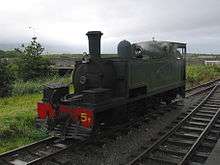TDLR 5
|
Restored No 5T running along the roadside near Blennerville. Taken in 1999 | |||||||||||||||||||||||||||||||||||
| |||||||||||||||||||||||||||||||||||
| |||||||||||||||||||||||||||||||||||
| |||||||||||||||||||||||||||||||||||
| |||||||||||||||||||||||||||||||||||
Tralee and Dingle Light Railway 5 is a 2-6-2T locomotive manufactured by the Hunslet Engine Company in 1892 for the Tralee and Dingle Light Railway.
It is difficult to understand why the Tralee and Dingle acquired this particular locomotive. Perhaps they were looking for a locomotive more suited to passenger work, the pony truck should give a better ride for the crews over lightly laid track, perhaps the extra truck was needed to keep the axle-weight down as No. 5 was some 9 tons heavier than the other, earlier Hunslets or, as it was fitted for oil-burning from new it could be that Hunslets, in looking for a narrow gauge railway on which to demonstrate their product, gave a good deal on the price, and railways were always looking for a good deal to help their finances. Regardless of which No. 5 arrived in 1892 and on the 1925 amalgamation became the sole representative of GSR Class 5T or Class PN2.
History
Tralee and Dingle locomotive No. 5 was delivered from its builders, The Hunslet Engine Company, of Leeds as their works number 555 in 1892, ready fitted for oil-burning. It is believed that this was a prototype and Hunslet were looking for a railway to demonstrate its product, one of the first for narrow gauge. The T&D also purchased two oil-burning units for fitting to its other locomotives but they were never used. No.5 was converted to burn coal after only a short career as an oil-burner.
Like the earlier Hunslet products No. 5 was delivered ready for “tramway” operation, fitted with “skirts” to cover the motion, a boiler mounted bell and headlights. As with the other locomotives the “skirts” had a short life and were removed to facilitate easy access to the motion oiling points etc.
A new boiler was fitted in 1906 and, being a favourite of the engine crews, it saw many miles under its belt before being stopped in 1948 and taken to Inchicore Works. It was outshopped in 1949 and, with no work on its home line, sent to the Cavan and Leitrim Railway where it served until final withdrawal from service in 1959. It was always said that this locomotive covered the most miles of all the T&D fleet it was so well liked by the crews, however this was put beyond doubt when it crossed the Atlantic in 1959 to return in 1988 to run again on its home metals.
A detailed article about building a model of 5T can be read /downloaded from here . This gives some detailed measurements and visible differences in the locos appearance over time. Pictures of the loco (and other TDLR Hunslets can be seen on Chester Model Railway Club's model of parts of the line here
Livery
Tralee and Dingle locomotive livery was a dark green lined out red between two cream lines. Buffer beams were red. Following the 1925 amalgamation the livery followed that of the GSR in that locomotives were painted plain grey with red buffer beams. It carried this livery, in common with other TDLR locos, on into CIÉ days, retaining it (though in filthy condition!) to the end.
Preservation

Locomotive No.5 was withdrawn from service in 1959 and bought by the Steamtown Museum, Vermont, USA where it was cosmetically restored to TDLR condition and placed on static display. In 1988, like the prodigal son (or as locomotives are considered female, daughter), No. 5 returned to Tralee where, after 5 years, it was restored to working order for duties on the 1½ miles reopened section of the TDLR between Tralee and Blennerville.
The locomotive is out of service after failing a boiler cert and the whole project has ground to a halt as a result. A decision on her future depends on funding. She now lies dismantled in her home Shed.
References
- Clements, Jeremy & McMahon, Michael (2008). Locomotives of the GSR. Newtownards: Colourpoint Books. p. 225. ISBN 978-1-906578-26-8.
